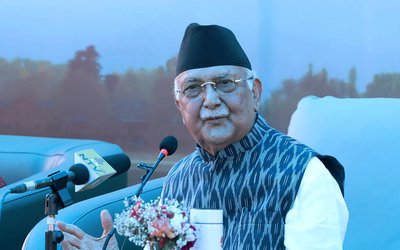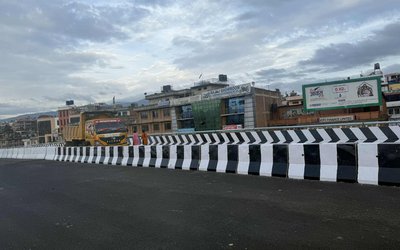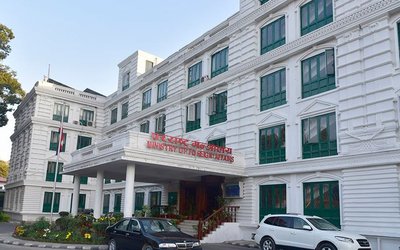More on News





Jagat Shrestha, a resident of Kakarbhitta, an IDU and HIV positive, started to use new needles. “I don’t want to infect other colleagues. This is the reason we use a separate needle for each individual,” said Jagat.
As awareness grows due to the campaigns of various non-governmental organizations along with groups living with HIV, the situation has drastically changed. Even local NGOs are supplying safe needles for individuals.
Resident of Atariya village of Kailali district of far western region, Sarala Chaudhari (name changed), 22, a commercial sex worker is encouraging her clients to use condom for safe sex. “No condom and no sex,” said Sarala, whose clients are mostly the truck drivers. Although the number of commercial sex workers like Sarala is still few, the awareness level among commercial sex workers about possibility of HIV infections through unsafe sex is definitely increasing.
With the resources provided by various INGOs and the government, free distribution of needles and condoms has increased in the areas like Kakarbhitta and towns like Attariya. “The only problem is the police now. Police put us behind the bars in case we carry condoms,” said Sarala.
The situation with the IDUs is also similar. “Carrying a couple of needles is always a possible way to go to prison.”
Nepal is described as having a “concentrated” HIV/AIDS epidemic, with by far the highest prevalence rates among high risk groups (or Most At Risk Populations, MARPs) such as labor migrants, injecting drug users (IDUs), men who have sex with men (MSM), female sex workers (FSW) and their clients. Labor migrants currently account for about 30% of all HIV infections as a significant proportion of their population has unprotected sex with multiple partners while abroad (most commonly in India).
NCASC reported total HIV infection as of 17 September, 2011, was Male 11,964, Female 6,571 and total 18,535. The cases reported in the month of September is 139.
As more resources are available to support HIV and AIDs programs, they have brought about positive results. Even Accham district of Far Western Region has seen some impacts following the launching of various intervention and prevention programs targeting the migrant workers and their families.
In the far western region, the government hospitals and health centers failed to carry out intervention programs. According to a study, most interventions for prevention for the most at risk populations Female Sex Workers (FSW), Injecting Drug Users (IDUs) and Males who have sex with Males (MSM)are not implemented by the government NCASC or HIV AIDS and STI Control Board (HSCB) but through some strong INGOs.
“I would like to request all Nepal’s development partners and other stakeholders, who had always been with NCASC in bringing NCASC to this point of achievements, to join hands to build more strong collaboration and partnership for greater achievements with available resources in responding to the
HIV epidemic in Nepal effectively,” Dr. Ramesh Kumar Kharel, Director of National Centre for AIDS and STD Control (NCASC), said.
“Since its establishment, NCASC has focused its activities in increasing service coverage to reach Most-At-Risk-Population(MARP) of the country, minimize transmission of HIV and provide treatment, care and support services to the people living with HIV who are in need. Despite many challenges, NCASC has gained enough momentum in managing HIV services to the people of the country and has also obtained necessary support from the government counterparts, civil societies, external donor partners and UN agencies,” said Dr. Kharel.
Had the flow of resources been coordinated better, the prevention and intervention programs would have become more effective. As there is no strong and effective system to coordinate and harmonise the inflow of resources aimed at prevention amongst Most at Risk Population, there are always disparities in distribution of funds in terms of regions.
“Nepal’s problem is not inadequate resources but the problem is with the management. There is a grant of USAID, the World Bank and Global Fund. The problem is the management and coordination,” said HIV expert Mahesh Sharma.
Looking at the recent trends, Nepal needs to go a long way to meet MDGs. Nepal’s other challenge is now to reduce the duplication of the programs and use the available funds for maximization of results. Experts argue there is a need of a strong mechanism for tracking resources to ensure the continuity of ongoing program in order to clearly reflect the coverage of donor supported programs and the duration of their support.
The major sources for HIV response in Nepal are public, bilateral, multilateral and private/INGOs. According to a study, eight key sources provide the majority of funds for the HIV response in Nepal. A total of US dollars 20.5 million were spent in 2009 and USD 19.1 million obligated for fiscal year 2010.
Among the major donors, Global Funds constitutes the major source of funding which provided 31.3 percent of funds for HIV response for fiscal year 2009, followed by DfID (30.9) and USAID (26.8).
The theme for this year’s World AIDS Day celebration is “Getting to Zero - Zero New HIV Infections. Zero Discrimination and Zero AIDS Related Deaths.” This will only be achieved by using the available resources in a coordinated manner as well as mobilizing them to reach the targeted population.
The theme was announced on 9 September 2011 in Cape Town, South Africa. This theme is backed by the United Nations “Getting to Zero” campaign and runs until 2015. It builds on last year’s successful World AIDS Day “Light for Rights” initiative encompassing a range of vital issues identified by key affected populations.
The overall WAD concept/overarching theme for the next four years will be “Getting to Zero” (till 2015) with the understanding that different groups and regions will focus on a zero which is most relevant to them.
The World AIDS Campaign adoption of “Zero AIDS-Related Deaths” is its World AIDS Day focus for 2011 under the overarching theme of “Getting to Zero”.
“Nepal therefore needs to decide if it will also adopt Zero AIDS-Related Deaths as its World AIDS Day focus for 2011 or if it will focus instead on Zero New Infections or Zero Discrimination or all three zeros.”
Game Changer
A new report by the Joint United Nations Programme on HIV/AIDS (UNAIDS), shows that 2011 was a game changing year for the AIDS response with unprecedented progress in science, political leadership and results. The report also shows that new HIV infections and AIDS-related deaths have fallen to the lowest levels since the peak of the epidemic. New HIV infections were reduced by 21% since 1997, and deaths from AIDS-related illnesses decreased by 21% since 2005.
“Even in a very difficult financial crisis, countries are delivering results in the AIDS response,” said Michel Sidibé, Executive Director of UNAIDS. “We have seen a massive scale up in access to HIV treatment which has had a dramatic effect on the lives of people everywhere.”
NCASC works as per the National HIV/AIDS Strategy developed and revised in regular intervals. It is currently putting its efforts in achieving the Millennium Development Goal of 'halting and reversing the spread of HIV epidemic' and in controlling sexually transmitted infection in the country.







